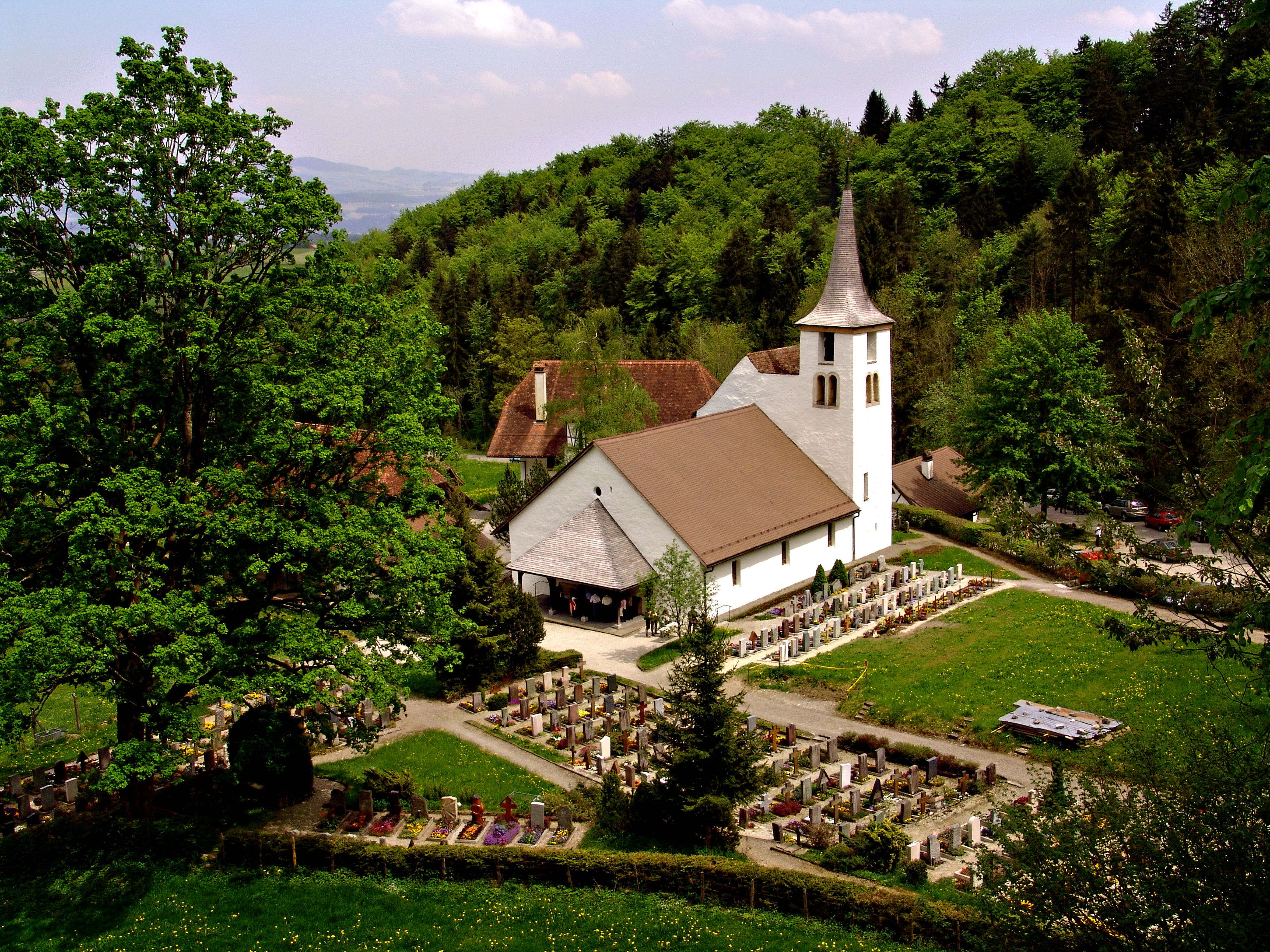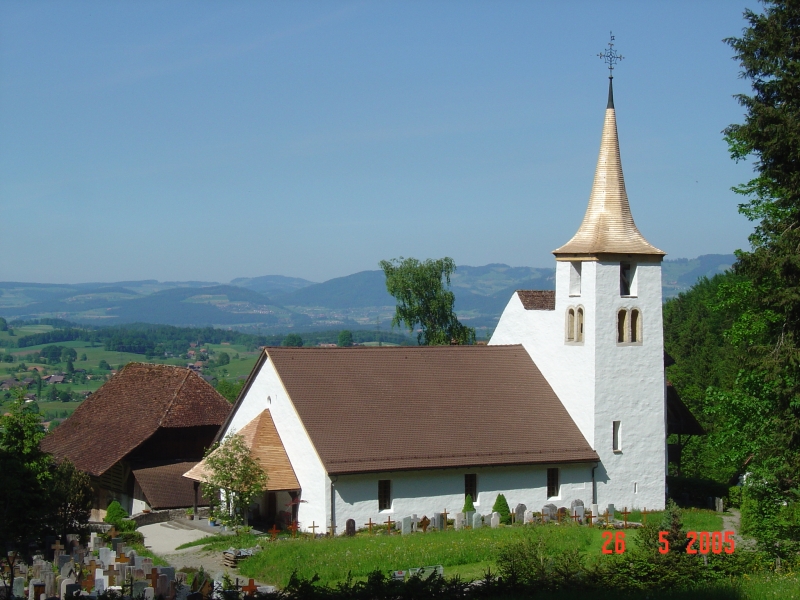Blumenstein
Blumenstein from the south, seen from Walalpgrat from
Blumenstein is a municipality in the administrative district of Thun in the canton of Bern in Switzerland.
- 4.1 Tourism
- 4.2 traffic
Geography
The municipality is the westernmost municipality in the administrative district of Thun. It lies on the north side of the Stockhornkette in the uppermost part of the Gürbetal and in Stockental. At its northern edge the Gürbe flows through. The community consists of two parts: on the one hand from Inner - Blumenstein with the village of Blumenstein and the hamlets Eschli, alleys, and Rüdeli Wäsemli; other hand, from the hamlets Bodenzingen, Lochmannsbühl and Reckenbühl ( together referred to out-of- Blumenstein ) and the formerly independent municipality of pine wood. There are also numerous groups of houses and farmsteads. From the municipal area of 1552 ha, half, 49.6 % used for agriculture. Other 38.0% is forest and woodland, and 8.5 % non-productive area ( such as rocks ) - especially in mountain areas towards Stockhornkette. And only 3.9% of the municipal area are overbuilt. The community lies on the edge of the in planning regional nature park gantrisch.
Population
The population rose strongly 1764-1850 to ( 1764-1850: 143.1 %). Then she went to 1900 as a result of migration to the industrial areas ( in and around Thun) sharply ( 1850-1900: -24.4 %). Between 1910 and 1930, and 1941-1960, there were two major growth spurts, so that the population reached a new peak ( 1910 to 1960: 37.7 %). By 1980 the number of residents dropped a little, but then increased to 2000 on a new high of 1,202 inhabitants. Since then, the population is reasonably stable. The majority of residents (60 %) are between 21-64 years old.
Languages
The people speak in everyday life, a high Alemannic dialect, which belongs to the German dialects of Bern. At the last census in 2000 gave 97.15 % German, 1.76% and 0.34 % Albanian French as a primary language.
Religions - faiths
In earlier times, all the inhabitants were members of the Evangelical Reformed Church. Due to immigration from other regions in Switzerland and abroad and leaving the church, this has changed. On December 31, 2007, the religions were as follows: 82 % reformed, 6% Catholic, 10% no religious affiliation, and 2% Other (Muslims and some gave no information about their creed ). The Muslims are almost exclusively of Albanian origin.
Origin - Nationality
The proportion of foreign immigration is low. December 31, 2007: Population 1176 inhabitants of which 39 foreigners. Of the 1,139 Swiss nationals had ten people more than one nationality. The few immigrants come from Serbia - Montenegro, Macedonia (in both cases mostly Albanians ), Germany, Italy, Spain, Sri Lanka and the Netherlands.
Policy
Regulators Haenni is community president (as of 2011 ).
The voting shares of the parties at the national elections of 2011 were: SVP 42.2 %, 15.5 % BDP, SP 13.6 %, 6.0 % EDU, EPP 5.8 %, 5.4 % GPS, glp 4.8 %, FDP 4.3 %, CVP 0.7 %.
Economy
Until well into the 20th century the village was dominated by agriculture. In addition, the cure played a significant role in the health resort Blumenstein bath. Until the 19th century the cereal and potato cultivation dominated agriculture before we started with the livestock industry on a large scale. Today ( as of 2000) working in the 32 farms have 87 employees. Industry and small businesses offer 153 persons an opportunity to work, while 119 people earn a living in the 27 service industries. Numerous flowers Steiner are now commuters - especially in the city of Thun.
Tourism
In earlier times, attracted mainly Blumenstein bath strangers. Today mainly come walkers and cyclists by Blumenstein. The community has declined to join in 2008 to the Regional Natural Park gantrisch.
Traffic
Blumenstein village has no railway line, but is well connected by bus to the network of public transport. From and after tuna served by lines 3, 50 and 51 of the STI. From and after Seftigen Station daytime line 53
Blumenstein is located on the road from Brodhüsi to Seftigen, but also has good road links to Thun. The nearest motorway connections are tuna and tuna -South - North on the A6.
History
The community was settled relatively late. The reign of Peter Raron Bluomenstein sold in 1348 to the city of Bern. The lower courts had different families. First, the gentlemen of Blumenstein, the last of Wattenwyl. A member of the latter family sold in 1642 his rule rights to Bern. For now, the place to Seftigen District Court, from 1658 to 1798 belonged to the district of Thun. From 1798 to 1803 Blumenstein was part of the Helvetic district Oberseftigen. Since then, the church belongs to the district of Thun. The hamlet of pine wood until its incorporation in 1859, an independent municipality (1850: 385 inhabitants).
Attractions
Worth seeing are the location on Fallenbach building group with church ( formerly St. Nicholas), rectory, and Küherhaus Pfrundscheune. This module is one of the monuments of national importance. Also, several old farmhouses are worth seeing for their own style.
Personalities
- January Cibula ( born 1932 ), physician, politician, founding president of International Roma Union









